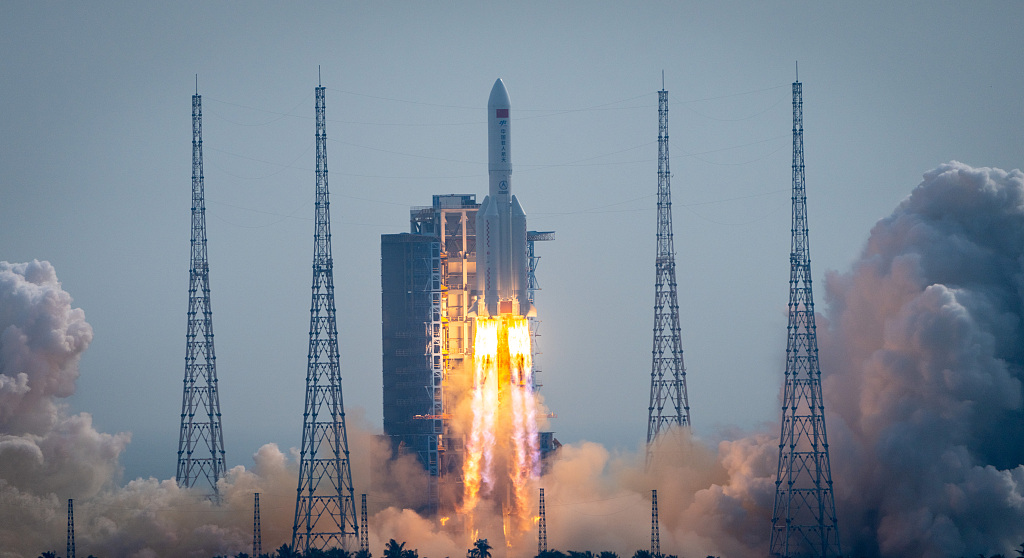
The Long March-5B Y4 carrier rocket, carrying the space lab module Mengtian, blasts off from Wenchang Spacecraft Launch Site in south China's Hainan Province, October 31, 2022. /Xinhua
The Long March-5B Y4 carrier rocket, carrying the space lab module Mengtian, blasts off from Wenchang Spacecraft Launch Site in south China's Hainan Province, October 31, 2022. /Xinhua
Editor's note: Marsha Freeman is the technology editor of Executive Intelligence Review magazine and the author of several books on space including, "How We Got to the Moon: The Story of the German Space Pioneers." The article reflects the author's views, and not necessarily those of CGTN.
After the Mengtian science laboratory docks with the Chinese space station and is checked out and goes operational, it will become the heart of the Chinese space station. A place where the astronauts will spend most of their time conducting experiments designed by scientists on the ground. Here the breakthroughs in science and technology that President Xi Jinping has deemed necessary must be carried out. Critics in the West often compare the Chinese space station with the International Space Station (ISS), in order to ridicule it. The Chinese station, named Tiangong, or Heavenly Palace, can only accommodate three crewpersons on long-term missions, while six can be accommodated on the ISS. The Chinese Space Station supports thirteen experimental racks, far fewer than on the ISS.
Nonetheless, the quality of ideas is not determined mathematically. The pace of development from the station will depend upon the commitment of the scientists on the ground and the crew on the station, and most importantly, the national government's support for research. The latter is lacking on the U.S. side. The station consists of three kinds of facilities for experiments. It contains an outside platform for testing materials in situ in outer space. Second are the racks inside the module, and third is the exposure platform for Earth observation and astronomy. Previous generations of similar instruments have flown on the ISS, but Chinese scientists could advance state-of-the-art instruments.
Additionally, the station will have a fellow traveler. A co-orbiting, Hubble-class telescope, called Xuntian, will have a two-meter-aperture comparable to Hubble, which features a field of view 300 times greater, allowing 40 percent of the sky to be surveyed over a decade. It can dock at the station for maintenance and repair.
To stimulate interest in young people in space station science, China established the youth program of scientific education, which has a preliminary list of dozens of projects already approved. The program is aimed at primary and middle-school children. Students worldwide can participate. China has also introduced a contest aimed at freshman and sophomores at universities to bring forth fresh ideas that could be carried out in a confined microgravity environment.

Students attend a live class given by the Shenzhou-13 crew members, in the Macao Special Administrative Region, China, December 9, 2021. /Xinhua
Students attend a live class given by the Shenzhou-13 crew members, in the Macao Special Administrative Region, China, December 9, 2021. /Xinhua
The life sciences and biology experiments are considered very important for the station. The life sciences encompass a broad range of phenomena, including synthesizing biological molecules in space to study life's origins. There they will conduct studies of plants and seeds for agriculture, and utilize a centrifuge that can subject small animals to various levels of gravitational force similar to that on the Moon. which is one sixth of Earth's gravity.
Gu Yidong, president of the China Society of Space Research, told the American Society for Gravitational and Space Research conference in Florida on November 3, 2013, "The main purpose of the space station will be life and physical sciences. To that end, the CSS life sciences effort will be divided into five areas: fundamental biology, biotechnology, space radiation biology, fundamental studies on cells, and interdisciplinary studies." The main purpose is to promote the understanding of the nature of life.
China: A major space power
Wang Xiang, commander-in-chief of China space station system, explained during a television interview earlier this year how China was becoming a major space power. "I think one manifestation of strength [in space] is whether you have a complete system. In fact, we have a very complete system, a space system including measurement and control capabilities, global navigation and positioning capabilities, ground support capabilities, rocket capabilities, launch site capabilities, recovery site capabilities, and so on. Our system is very complete and completely autonomous and controllable," he said. "Why is the space station one of the symbols of a major space power? Because the space station does not fly by itself, but behind this station we have such a complete and powerful space system."
Looking forward, Wu Yansheng, chairman of China Aerospace Science and Technology Corporation, speaking on the sidelines of the 20th National Congress of the Communist Party of China on October 22, said that the country has set up an innovation institute, the China Academy of Aerospace Science and Innovation, to accelerate its cutting-edge technology development, focusing on artificial intelligence, advanced detection, materials and power. Wu also indicated that the country will work on new and better rockets, concentrating on human-rated and heavy-lift vehicles, manned missions to the Moon, a mission to collect samples from Mars, and exploration of asteroids.
China officially approved the space station program in 1992. At that time the country's GDP was 1/26 of what it is today. It took foresight and commitment, as well as an optimistic view of the future that sustained such a commitment for over so many years. This should be an important lesson for countries today just entering the space age.
(If you want to contribute and have specific expertise, please contact us at opinions@cgtn.com. Follow @thouse_opinions on Twitter to discover the latest commentaries in the CGTN Opinion Section.)